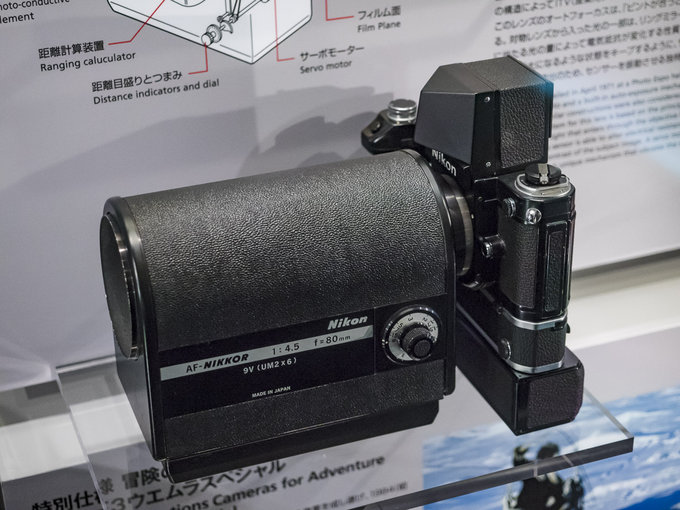Nikkorauto focus lenses for single lens reflex cameras (film and digital)
Introduction
Nikon Corporation showed a prototype auto focus lens at the 1971 Phot-expo in Chicago (USA). It was a huge, nearly 3 kilo weighting lens with a focal length of 80 mm. and a maximum aperture of f/4.5 (see above). It was impossible to use it for handheld photography but Nikon wanted to show that it didn´t neglect modern camera and lens technology. Fellow camera and lens manufacturers were developing AF-systems. In particular Canon and Minolta were speeding up developments with auto focus compact cameras, followed by their first single lens reflex cameras with auto focus and built-in motor drives. Nikon introduced a Nikon F3-AF with two AF-lenses (2.8/80 mm. & 3.5/200 mm.) in April 1983. This expensive set didn´t become a great success. In 1986 the Nikon F-501 (alias N2020) was Nikon´s first real AF-SLR. Of course AF-lenses had to be available too. Nikon secretly developed various lenses: by the end of 1986 twelve different AF-lenses were introduced!! From that year on the advance of the AF-lens was unstoppable. To date more then 150 different versions of AF-lenses have been produced. In the early 1990´s - less than 10 years after the introduction of the first range of AF-Nikkor lenses - sales of AF-lenses surpassed the sales of manual focus lenses. A few years ago Nikon stopped producing manual focus lenses; just a few are still in production, some on special request only. Nikon has produced a wide range of AF-lenses; every year several new varieties and versions are introduced. Despite the variety of lenses, all lenses fit nearly all SLR-cameras Nikon ever produced. All lenses have the famous F-mount, although their focus may differ. Nikon made special AF-lenses to fit the modern digital SLR´s with half frame (in comparison to 35mm. photography) sensor (DX), full frame (FX) digital SLR, APS cameras and even a Nikonos camera (Nikonos RS with its own lens mount). When mounting a ´normal´ (35mm. film) AF-lens on an APS- or DX-camera a crop factor has to be considered. (If 35mm. film = 1, APS = 0.8 X; DX = 0.65 X; CX = 0.37 X). In March 2001 Nikon introduced a new lens construction, the so called G-mount lens. The very first lens with a G-mount is the AF-Nikkor 3.3-5.6/28-80 mm. In fact these lenses do have the F-mount but there is no aperture ring. As these lenses are used on modern SLR cameras with the P/A/S/M-programs the aperture setting is done electronically and not mechanically, making an aperture ring obsolete. This evolution may save space and weight and increase speedy settings, the disadvantage is that these lenses cannot be used on older non-AF camera bodies. When ever buying a G-lens be aware of this fact. Note: All Nikon SLR cameras offering auto focus have a built-in AF-sensor which will be accurate as long as the maximum aperture of the lens or lens-teleconverter-combination is f/5.6 or more (= lower f-number). If lenses (or combinations) are used with a maximum aperture of f/8 and smaller (= higher f-number) auto focus will not work. Warning: Nikon produced some lenses with a plastic lens mount. These mounts can break easily, so be careful with these lenses or just don't buy them. Nikon should stop producing lenses with a plastic lens mount!!
fish-eye lenseswide-angle lensesstandard lensesportrait lensesshort tele-lenseslong tele-lenseswide-angle zoom lensesstandard zoom lensestele zoom lensesvibration reduction lensestilt & shift lensesmacro lensesspecial lenses
|
